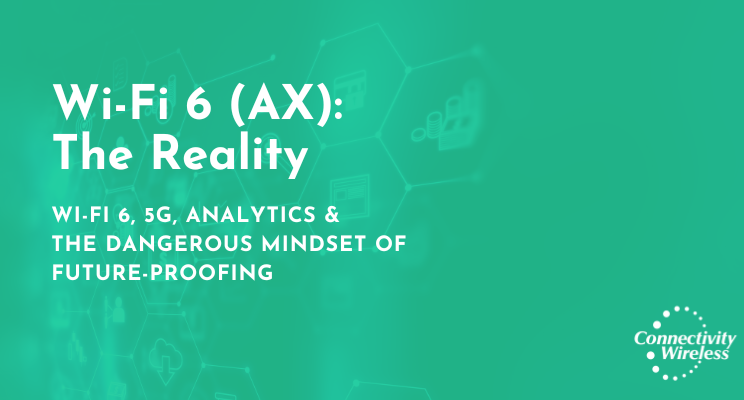April 28, 2021
Wi-Fi 6, 5G, Analytics & The Dangerous Mindset of “Future-Proofing”
Now that Wi-Fi 6, which used to be 802.11AX in geek speak, has been around for a few years, what have we learned? Well, we know its throughput speeds are faster, it facilitates superior device performance in dense environments, and it has enabled the promise of applications like virtual reality (well…to become a reality). If you’re a user on a Wi-Fi 6 network, these improvements are just lovely. All you know is the search engine on your device seems faster, your Call of Duty game is screaming fast, and your business applications are ready, available, and robust.
If you’re an IT department, you see more APs, possible points of failure, and outrageous expectations of 100% uptime at the highest possible performance. Just wait for a network performance issue to crop up. Any IT’er worth their mettle will tell you the issue is hardly ever due to Wi-Fi itself. But let that network slow down for a second, and all hell breaks loose. To the users, it’s ALWAYS the Wi-Fi.
Future-Proofing Your Wi-Fi Network
As with all things, balance is important. The Wi-Fi 6 world is no different. Organizations must balance expectations with reality and be careful not to get stuck in the rut of the upgrade cycle.
The perpetual “future-proofing” conversation (that typically pits IT departments against business stakeholders) must create an understanding of what technology can do juxtaposed against the withering sting of unreasonable expectation. Although it has powered history and will accelerate our futures, it must be reined in and deployed thoughtfully with clear expectations.
Thoughtful consideration of Wi-Fi 6, CBRS, 5G, and other access technologies is important to the success of your business. Keep in mind that the promise of any technology is fleeting as time never stands still. New technology is on the horizon before the sun sets on the previous version, and the urge to get the “latest and greatest” is hard to resist. Engage with thought leaders and trusted partners like Connectivity Wireless to help you wade through the endless questions. We can help you decide what you need when you need it.
5G and Wi-Fi 6

Speaking of 5G, we’ve been hearing rumors of the holy grail of access technologies for some time now. “The main advantage of this technology is massive throughput improvements over prior versions, faster network speeds, and lower latency leading to vastly improved wireless service for a greater number of connected devices.” This sounds like the value proposition behind Wi-Fi 6. They both have similar performance advantages over prior versions; they both have issues that arise with coverage area as the signal strength doesn’t travel as far as prior versions, and they both require a greater density of access points to function as promised.
Do you remember those business stakeholders mentioned about before? They likely know very little about any of this. All they know is that device connectivity must be ubiquitous, robust, and stable. For IT staff and leadership, it’s just not that simple. The questions of when to deploy, what to deploy, and how to deploy will all lead to critical decisions that could impact the very success of the organization. The technology selected can open doors to new business processes, streamline operational dynamics, and enable a variety of IoT applications. With that promise, how does one decide what to deploy? Some simple decision points can aid organizations in selecting the right technology for them.
Combing Wi-Fi and 5G for Seamless Connectivity
Likey, and depending on the needs, the deployment will be a combination of Wi-Fi 6 and 5G. Think of a seamless world of wireless connectivity:
You rise in the morning, grab a coffee, turn your wireless device on, and read the morning news on your Wi-Fi 6 home network. You get ready for your day, jump in the car, set the GPS, and head out for your first appointment of the day while seamlessly switching from your home Wi-Fi 6 network to the pervasive 5G cellular network.
After nailing your first appointment, you head to the office to check in and do some emails. Your device again seamlessly switches from the 5G network to the Wi-Fi 6 in your office without any noticeable decrease in performance. You didn’t have to log in at the office because the network recognized your device from prior authentication.
You finish up at the office and head to meet a prospect at the local coffee shop. You don’t know it, but your device associates with the Wi-Fi 6 network when you walk into that coffee shop. Most Wi-Fi-enabled devices are designed to opt for Wi-Fi networks over cellular when available, as performance and reliability in those environments are better. This “data offload” also helps the cellular carriers because it frees up capacity on their 5G network. Sounds easy, right? Sure. However, there are means to help you decide what to do and how to do it, and you can learn from what your network is trying to tell you right now.
Wireless Analytics

One place to turn for answers is analytics. Measuring guest behavior can be very valuable when considering what technology to deploy in your next upgrade cycle. Any network change should be user-driven, NOT time-driven. The old adage of “if it ain’t broke, don’t fix it” holds true. Just because Wi-Fi 6, CBRS, and 5G are available doesn’t mean you drop everything and upgrade.
Careful consideration of user lode, measured network latency, guest behavior, and other analytics collected will give you a clear picture of your network’s capabilities and afford you a better opportunity to be successful when selecting a technology.
Although beneficial, basic network performance statistics like signal strength, device count, and bandwidth consumption are only part of the story. When considered in conjunction with actual guest behavior measured by the collection of footfall and dwell time data, a network operator gains the full picture of what’s happening in their network and can make educated decisions about what to do next if anything.
The promise of Wi-Fi 6 is exceptional application performance, screaming network speeds, and support for the vast world of IoT. Just make sure you’re armed with as much information as possible instead of making a best guess. It is possible as much as your vendor wants to sell you something, you may not need it. Yet.
